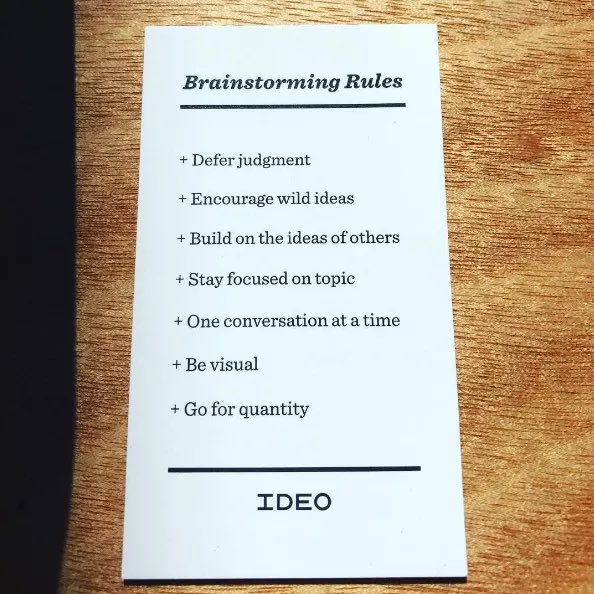头脑风暴是个听起来很现代化的技巧,但它其实是一个百年前的想法,并在 60 多年前就已传播得广为人知。如今大大小小、各行各业的公司也都会在日常使用头脑风暴这个工具,但其实际的效果差别很大,这当中会有各种各样的实操问题。但不管怎样,头脑风暴作为一种脑力练习是值得推崇的,可以帮助我们自己跳出许多思维定式以及鼓励我们打破惯性。
头脑风暴的七条原则
为了更有效地进行头脑风暴,知名的设计公司 IDEO 曾经提出头脑风暴的 7 条原则。具体如下:
1. Defer Judgment 暂缓评论
不要急于对别人的观点发表是非对错的评论,这样会打击提出点子者的积极性,且把集体思维的联想和延展打断。这也是对提出点子的人的尊重。
2. Encourage Wild Ideas 鼓励大胆想法
许多人日常总是怕说错话,在别人发言时,脑子想的是“我要怎么讲是对的”、“我要怎么讲才能表现我的水准”。这是因为许多人成长经历中就缺乏允许异想天开的环境。只有让异想天开大行其道,才能鼓励每个人真正去敢于思考,而不是纠结在表达的水准和对错上。
3. Build on Ideas of Others 借“题”发挥
有些时候别人会提出来很疯狂的点子,你自己虽然是专家,知道行不通,但在座的很多不是专家,说不定听到这个疯狂的点子会得到启发、获得灵感,在这个疯狂点子的基础上,提出更实际的方案。所以,只有在暂缓评论的环境下,才能让更多的人借异像天开的点子发挥。
以上前三个原则是鼓励出好点子的环境基石。
4. Stay Focused on Topic 不要离题
每一次讨论,要定一个明确的题目,不然的话异想天开的结局是不能收敛。
5. One Conversation at a Time 一次一人
讲话的时候保持同时间只能一个人讲,不要七嘴八舌的。
6. Be Visual 图文并茂
鼓励大家在想点子的时候,把这个点子用图案的方式画出来。不是很会画图也没关系,这是因为,有时收集了很多很多点子张贴在墙壁上,也许有几百个,你过几天再回去看,如果只有文字的话,有的时候会想不起来这到底是什么,画图可以帮助记忆。
7. Go for Quantity 追求数量、非质量
在规定时间内鼓励大家尽量讲,追求数量。IDEO 公司内部一般一个小时可以汇集 100 个点子。IDEO 特别推崇诺贝尔获奖者 Linus Pauling 的一句话就是:“要得到好的点子,首先要获得很多点子。The Best way to get a good idea is to get a lot of ideas.”

IDEO 公司的每一个会议室白板上方,都贴著这样的七项原则。不过,好的流程、规则也并不能完全保证有完美的头脑风暴,因为最终的执行还是靠人。
因此最好每个人在日常都习惯自己做头脑风暴,掌握一些基本的思路和方法,这里推荐我开发的应用 创意便签(InspireNote),它特别适合创意工作者、设计专业学生等作为日常的想法备忘录。点击下方按钮即可在苹果 App Store 进行下载(暂无安卓版本)。
The Seven Principles of Brainstormin
To make brainstorming sessions more effective, the renowned design firm IDEO introduced seven key principles, which are as follows:
- Defer Judgment
Refrain from passing immediate judgment on others’ ideas. Criticizing ideas too soon can discourage participants and disrupt the flow of collective thought. Respecting contributors fosters an open, creative environment. - Encourage Wild Ideas
Many people hesitate to speak up, worried about saying the “wrong” thing or failing to meet a certain standard. This often stems from a lack of exposure to environments that embrace outlandish ideas. Encouraging wild, unconventional thinking inspires participants to focus on genuine creativity rather than perfection or correctness. - Build on the Ideas of Others
Sometimes, seemingly outrageous suggestions from others can spark fresh inspiration. Even if an expert knows an idea won’t work, it might lead non-experts to an innovative, practical solution. Creating a space free of premature criticism allows the group to build on each other’s ideas effectively.
The above three principles form the foundational environment for generating great ideas.
- Stay Focused on the Topic
Every session should have a clear, well-defined focus. Without it, the free flow of ideas might veer off course and become unmanageable. - One Conversation at a Time
Ensure only one person speaks at a time. Avoid chaotic, overlapping discussions that can derail the process. - Be Visual
Encourage participants to sketch out their ideas, even if they’re not skilled artists. Visual representation helps clarify concepts and aids memory. When reviewing hundreds of ideas later, visual cues can often convey meaning more effectively than words alone. - Go for Quantity Over Quality
During brainstorming, prioritize quantity. Aim for as many ideas as possible within the allotted time. At IDEO, teams often generate over 100 ideas in just one hour. The company emphasizes Linus Pauling’s famous quote:
“The best way to get a good idea is to have a lot of ideas.”
However, even with the right process and rules, successful brainstorming ultimately depends on the people involved.That’s why it’s crucial to cultivate the habit of brainstorming independently. By mastering some basic methods and approaches, individuals can enhance their creative thinking daily.
To support this, I’ve developed an app called InspireNote, a perfect tool for creative professionals, design students, and anyone looking for a reliable way to capture and organize their ideas. Download it now from the Apple App Store (currently iOS only).



